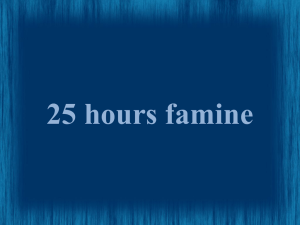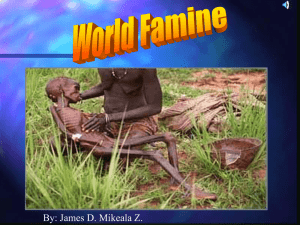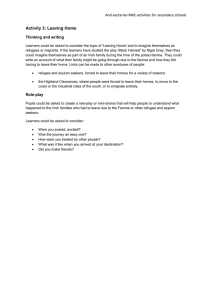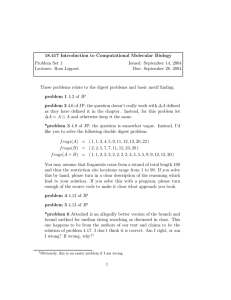Grade level: 9-12 Famine curriculum
advertisement
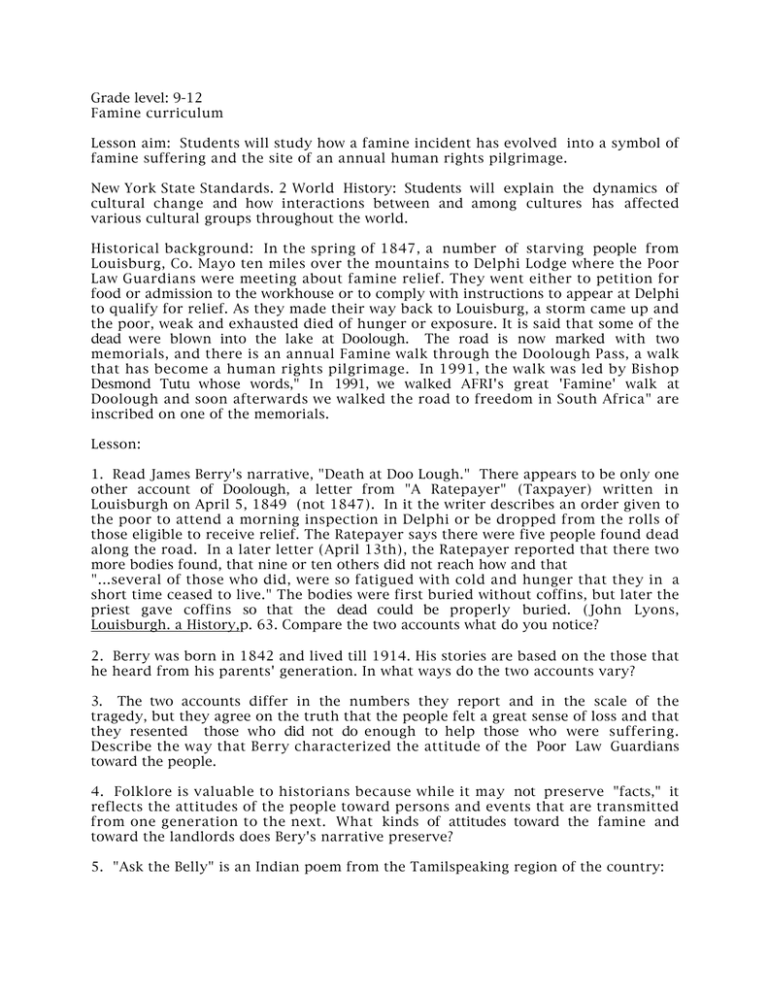
Grade level: 9-12 Famine curriculum Lesson aim: Students will study how a famine incident has evolved into a symbol of famine suffering and the site of an annual human rights pilgrimage. New York State Standards. 2 World History: Students will explain the dynamics of cultural change and how interactions between and among cultures has affected various cultural groups throughout the world. Historical background: In the spring of 1847, a number of starving people from Louisburg, Co. Mayo ten miles over the mountains to Delphi Lodge where the Poor Law Guardians were meeting about famine relief. They went either to petition for food or admission to the workhouse or to comply with instructions to appear at Delphi to qualify for relief. As they made their way back to Louisburg, a storm came up and the poor, weak and exhausted died of hunger or exposure. It is said that some of the dead were blown into the lake at Doolough. The road is now marked with two memorials, and there is an annual Famine walk through the Doolough Pass, a walk that has become a human rights pilgrimage. In 1991, the walk was led by Bishop Desmond Tutu whose words," In 1991, we walked AFRI's great 'Famine' walk at Doolough and soon afterwards we walked the road to freedom in South Africa" are inscribed on one of the memorials. Lesson: 1. Read James Berry's narrative, "Death at Doo Lough." There appears to be only one other account of Doolough, a letter from "A Ratepayer" (Taxpayer) written in Louisburgh on April 5, 1849 (not 1847). In it the writer describes an order given to the poor to attend a morning inspection in Delphi or be dropped from the rolls of those eligible to receive relief. The Ratepayer says there were five people found dead along the road. In a later letter (April 13th), the Ratepayer reported that there two more bodies found, that nine or ten others did not reach how and that "...several of those who did, were so fatigued with cold and hunger that they in a short time ceased to live." The bodies were first buried without coffins, but later the priest gave coffins so that the dead could be properly buried. (John Lyons, Louisburgh. a History,p. 63. Compare the two accounts what do you notice? 2. Berry was born in 1842 and lived till 1914. His stories are based on the those that he heard from his parents' generation. In what ways do the two accounts vary? 3. The two accounts differ in the numbers they report and in the scale of the tragedy, but they agree on the truth that the people felt a great sense of loss and that they resented those who did not do enough to help those who were suffering. Describe the way that Berry characterized the attitude of the Poor Law Guardians toward the people. 4. Folklore is valuable to historians because while it may not preserve "facts," it reflects the attitudes of the people toward persons and events that are transmitted from one generation to the next. What kinds of attitudes toward the famine and toward the landlords does Bery's narrative preserve? 5. "Ask the Belly" is an Indian poem from the Tamilspeaking region of the country: Scratch your head Bite your tongue Grin Bow low Keep your hands tied Your feet pressed firmly together "What's all this?" You'd better Ask the belly, It'll tell you. Shanmuga Subbiah trans. from Tamil by T.K. Doraiswamy Do you think the poem describes the poor who died at Doolough? Why? 2. Why has the Doolough Pass become an important famine symbol? What elements of Berry's Doolough story contributed to its significance? Death at Doo Lough (from James Berry, Tales of the West of Ireland. ed. Gertrude M. Horgan. Dublin: Dolmen,1966. pp. 39-42. On that day some four hundred of them arose shivering in their rags, all barefooted and still without food; they sighed and looked up to heaven before setting out on a journey from which none of them ws to return. When they reached Glankeen, they had to wade through the river which was swollen by recent rains. The rags from the hips downward were saturated with water on that cold, damp day. When they reached the southern bank of this rapid mountain torrent, there was nothing even resembling a road between that spot and Doolough, so that they had to negotiate the dreadful goat track along the brow of the precipice which overhangs the house of the late Captain Houstan. They encountered another river far deeper than that of Glankeen,and since there were no bridges in those days they had to battle their way through the stream, with the result that they were wet to the waist. When the wet and suffering peasantry reached Delphi Lodge, the viceguardians were at lunch and could not be disturbed, so the people sat down in their damp, miserable rags among the pine trees, and there many of them expired. When the two gentlemen condescended to see the peasantry, they refused to grant them relief or tickets to the workhouse, so the fearful journey had been all in vain. Night was no approaching and ten long weary miles of a wild, uninhabited region lay between them and that land where once had stood their happy homes. Now they were homeless, and with despair in their hearts they set out once more for the place of their birth. When they reached the river where Houstan's house now stands, they once more had to wade through it, saturating their rags anew. The wind veered around to the north-west bringing a storm with showers of piercing hailstones. Their wet rags began to stiffen like cold sheet iron around their emaciated limbs, and soon they began to fall and die along the rough path, or to fall in their weakness into the lake below. When they reach that terrible spot called the Stroppabue, on the very brow of the cliff, the tremendous squalls swept them by the score into the lake, and those whowere trying to climb the steeo-slanting pass or stroppa, lost their hold and fell as they climbed. The corpses which fell into the lake were never recovered. The few who survived he struggle through the Stroppa-bue continued to fall and die unti the last of them perished on the southern bank of the Glankeen river. On the next morning the trail from Glankeen to Houstan's house was covereed with corpses as numerous as the sheaves of corn in an autumn field. There is nothig in Irish history to equal this horrible butchery, nor is there anything in the history of Europe to equal it in horror, save the tragic retreat of Napoleon's army from Moscow. On the following day, the Relieving Officer took gangs of starving men with hm from Louisburgh along the corpse-strewn trail, and they buried the slaughtered peasants without coffins just where they fell. When they reached Doolough there was no earth along the goat track deep enough for graves save in the little glen or ravine which ran down to the brow of the cliff, and which frowns above the dark lough just beside the terrible Stroppe-bue. So they had to carry them to the little glen where they buried them in pits just as on a battlefield, and there they lie sleeping where the sighing of the winds through the tall, wild ferns which wave above their nameless graves forever sings their requiem.
